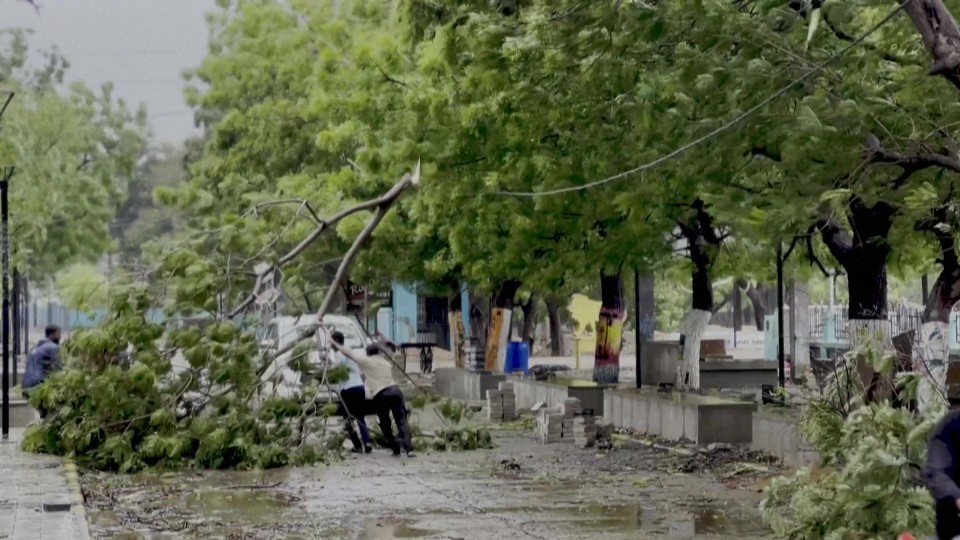

By Glenda KWEK and Ashraf KHAN in Badin, Pakistan
Agence France-Presse
MANDVI, India (AFP) — Cyclone Biparjoy slammed into the Indian coast with powerful winds, sowing fear and prompting evacuations, but began weakening in the early hours of Friday as it moved north.
Indian forecasters had warned that Biparjoy, whose name means “disaster” in Bengali, was likely to devastate homes and tear down power lines as it barrels through the western state of Gujarat.
The “very severe cyclonic storm” crossed the coastline near Jakhau Port Thursday evening, but started losing force several hours later and at 2:30 am (2230 GMT) on Friday was packing 100 kilometers (62 miles) per hour winds with gusts up to 110 km/h, the Indian Meteorological Department (IMD) said in the latest bulletin.
“It would move northeastwards and weaken into a cyclonic storm by early morning of the 16th (of) June,” the bulletin read.
Earlier, weather officials had said that the cyclone was expected to move overnight into Pakistan’s Sindh province, home to the port megacity of Karachi.
Jayantha Bhai, a 35-year-old shopkeeper in the Gujarat beach town of Mandvi, told AFP before the storm hit that he was afraid for his family’s safety.
“This is the first time I’ve experienced a cyclone,” said Bhai, a father of three boys aged between eight and 15, who planned to wait out the cyclone in his small concrete home behind the shop.
“This is nature, we can’t fight with it,” he said, as driving rain lashed his home.
– ‘Widespread damage’ –
Low-lying roads started to flood on Thursday afternoon after hours of rain.
Gusting winds blew sheets of water that reduced visibility with a dull grey mist.
Almost all stores were closed, and shoppers had crowded the few that remained open to buy last-minute food and water supplies.
India’s meteorologists warned of the potential for “widespread damage”, including the destruction of crops, “bending or uprooting of power and communication poles” and disruption of railways and roads.
The Gujarat state government said 94,000 people had relocated from coastal and low-lying areas to shelter.
Pakistan’s climate change minister Sherry Rehman said around 82,000 people had been moved from southeastern coastal areas in the face of “a cyclone the likes of which Pakistan has never experienced.”
Many of the areas affected are the same inundated in last year’s catastrophic monsoon floods, which put a third of Pakistan under water, damaging two million homes and killing more than 1,700 people.
“These are all results of climate change,” Rehman told reporters.
Storm surges were expected to reach four meters (13 feet), with flooding possible in Karachi — home to about 20 million people.
In the largely abandoned fishing town of Zero Point — so-called because of its proximity to the Indian border — 20-year-old Jaffer Ali said residents “are afraid of what is coming.”
The shanty settlement of hundreds of thatched homes was populated mainly by stray cats and wild dogs, with at least a hundred idle fishing boats tethered to a long pier running out to the ocean.
“Our worst fears are that it will come in the evening or later tonight,” Ali told AFP.
– ‘Terrified’ –
About 200 people huddled together in a single-storey health center in Kutch district, a short distance from India’s Jakhau port, late on Wednesday.
Many were worried about their farm animals, which they had left behind.
Dhal Jetheeben Ladhaji, 40, a pharmacist at the health center, said 10 men had stayed behind to look after hundreds of cattle crucial to their village’s livelihood.
“We are terrified, we don’t know what will happen next,” Ladhaji said.
Cyclones — the equivalent of hurricanes in the North Atlantic or typhoons in the Northwest Pacific — are a regular and deadly menace on the coast of the northern Indian Ocean, where tens of millions of people live.
Scientists have warned that storms are becoming more powerful as the world gets warmer with climate change.
